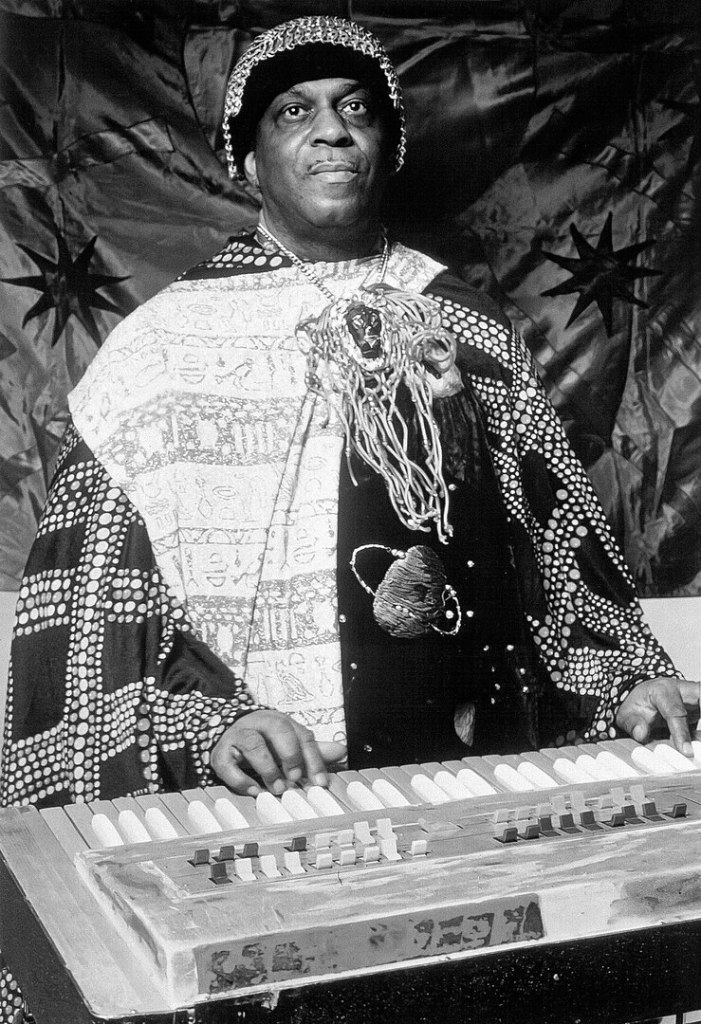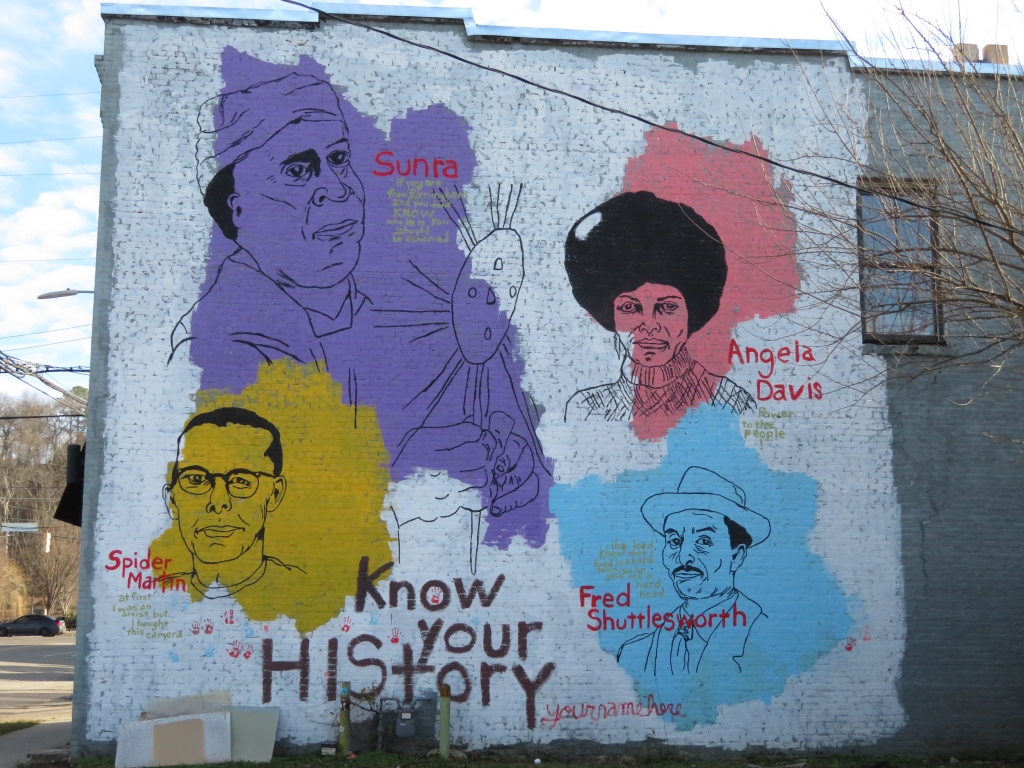Birmingham’s Citizen from Saturn
By Erin Elliott
Throughout history, music has broken down the barriers of class, race, and religion to unite people. This was especially true during the civil rights movement that fought segregation throughout America. Sun Ra, a famous jazz musician and civil rights activist, said “A band can demonstrate unity among men more than anything else in the world” (Rusch 1984, 7). Born Herman Poole Blount in Birmingham, Alabama, in 1914, Sun Ra was known for his experimental music style and out-of-this-world ideas. In 1922, during Ra’s childhood, King Tut’s tomb was discovered in Egypt. This increased public interest in African culture and increased the pride of African Americans in their heritage. Ra was fascinated by his ancestral roots.Young Ra showed an affinity for three things: music, ancient Egypt, and outer space. He incorporated his interest in ancient Egypt into his music and later changed his name to Sun Ra, based on the name of the Egyptian god of the sun.
Originating in New Orleans, jazz is a genre of music that showcased Black musicians and vocalists. This community quickly spread through the nation, popularizing its swinging tunes and complex rhythms (Matthews 2023, 4). Sun Ra grew to love jazz. His passion and talent for playing music led him to jazz and big band music in the 1940s, when this genre was widely popular. He added his own spin to the music, venturing to experiment with electronics and the synthesizer to cultivate an eclectic music style that was “an expression of an urgent, interplanetary mission” (Matthews 2023, 130).
Sun Ra and the Arkestra
In his college years, Ra claimed to have an alien encounter in which he was transported to Saturn and revealed his life’s purpose. The aliens said he was a sort of “chosen one” and that it was his destiny to go beyond the limits of human imagination in order to free the African Americans caught in the struggle for civil rights. They told him that he had a more meaningful future, and that when life on Earth seemed most hopeless he would finally be able to speak. (Matthews 2023, 139) He believed that African Americans would never be free on Earth, so freedom could only come from beyond the stars. Though a leader in various bands, Ra’s most famous was called Sun Ra and the Arkestra. It is said that “Sun Ra combined the word ‘orchestra’ and the word ‘Ark’, used both in the Old Testament’s Ark of the Covenant as well as referring to the ark that transported the Egyptian god Ra . . . . Not only did the group combine a collection of musicians, but it also encompassed multifaceted performance art and a mythological world” (Crider 2014, 62).
Music and Mythology
Known as the pioneer for “Afrofuturism”, Sun Ra combined both his interest in space and ancient Egyptian culture to create his aesthetic. This style is still seen today in pop culture through movies such as Marvel’s Black Panther and literature such as Octavia Butler’s Parable of the Sower. Afrofuturism can be defined as using “Black history, culture, science fiction and futurism as a way to reimagine the past and create a better present and future that doesn’t center oppression” (Starr Dunigan 2023). This was present in Ra’s eclectic style of music, space-age wardrobe, and mystical performances which appealed to a younger generation. Sun Ra and the Arkestra played all across the country, bringing millions along on their journey to outer space. Each member of the band (sometimes up to sixty people) wore a rainbow of Egyptian-inspired garb; both playing their instruments and dancing in a bizarre fashion. (Matthews 2023. 134). Often, the Arkestra members made their own album covers, featuring their outlandish styles of clothing and almost always a touch of the cosmos.

Birmingham’s Tributes to Sun Ra
Though never claiming Birmingham as his true home, the city of Birmingham claims Sun Ra as a true citizen and member of the community. “For much of the twentieth century, the city of Birmingham was home to . . . a thriving network of musicians whose lives helped shape the culture and sound of jazz as we know it” (Matthews 2023, 3) where Sun Ra was an idol. From murals to memorials, tributes to this legendary star can be found scattered among the city. The most recent installation can be found on the north side of the 1890 former fire station on 41st Street North in Avondale. It is just a block from the popular Redeemer Community Chruch. The colorful mural depicts four civil rights heroes with ties to Birmingham: Fred Shuttlesworth, Spider Martin, Angela Davis, and Sun Ra. Underneath Sun Ra’s the mural states, “If you are from Birmingham and you don’t KNOW who this is you should be ashamed” (Carmen Waldrop, 2021). Due to both his experimental music and creation of Afrofuturistic style, Sun Ra is seen as a prominent figure for civil rights. Demonstrating the importance of being yourself and using your imagination, Ra has inspired countless others to furthering the spread of pride in Black culture and art.

Know Your History
Memorial form: Mural painted on brick
Artist: Tim Kerr
Created and Installed: 2016-17
Location: Firehouse Community Arts Center, 412 41st Street South, BIrmingham, Alabama 35222
References
Crider, Beverly. 2014. Legends and Lore of Birmingham and Central Alabama. Charleston, SC: The History Press
Matthews, Burgin. 2023. Magic City: How the Birmingham Jazz Tradition Shaped the Sound of America. Chapel Hill: The University of North Carolina Press.
Rusch, Robert D. 1984. Jazztalk: The Cadence Interviews – 10 Jazz Masters Speak Candidly of Their Lives and Music. Secaucus, New Jersey: Lyle Stuart Inc.
“Spring Street Fire House” 2021 Bhamwiki. Updated December 18, 2021. https://bhamwiki.com/w/Spring_Street_Fire_House
Starr Dunigan, Jonecne. 2023. “Space is our place: How an Alabama city became a launch pad for afrofuturism” Reckon May 22, 2023, https://www.reckon.news/black-joy/2023/05/space-is-our-place-how-an-alabama-city-bec ame-a-launch-pad-for-afrofuturism.html
Erin Elliott ’27 was a student in a UCS 102: Icons & Memorials in Samford University’s Howard College of Arts and Sciences in spring 2024.
Published April 4, 2024.